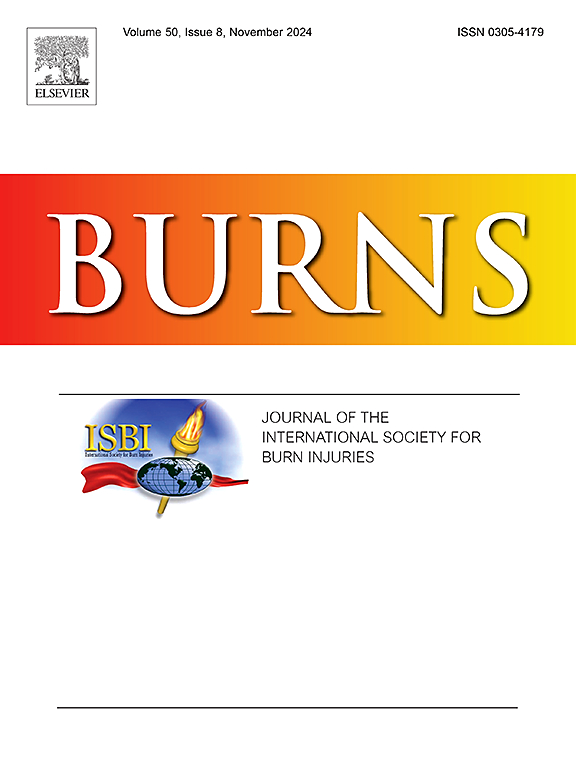靶向Cx43治疗可降低大鼠烧伤NLRP3炎性体的激活。
IF 3.2
3区 医学
Q2 CRITICAL CARE MEDICINE
引用次数: 0
摘要
烧伤是一种动态损伤,其特征是最初的坏死区发展到周围组织。急性炎症和细胞死亡是促进烧伤进展的两个主要因素。这些过程是由烧伤和慢性创伤中的连接蛋白43 (Cx43)半通道和间隙连接调节的。特别是,cx43介导的ATP释放可能与P2X7受体相互作用,激活NLRP3炎性体途径。本研究使用大鼠深度部分烧伤模型来评估Cx43反义寡脱氧核苷酸(Cx43asODN)或Cx43半通道阻断剂Tonabersat对炎症小体激活的抑制作用及其作为烧伤损伤潜在治疗方法的应用。通过免疫荧光分析,我们的数据显示Cx43asODN或Tonabersat降低了Cx43半通道和间隙连接的表达。与此同时,它们可以轻微和短暂地降低P2X7的表达、炎症小体的组装和炎症。H&E、马松三色和小红定量分析显示,烧伤创面治疗后表皮厚度减少,胶原蛋白保存改善。总之,我们的研究结果表明,cx43介导的NLRP3炎症小体途径可能通过P2X7激活参与早期烧伤创面愈合。这表明靶向Cx43可能具有改善愈合结果的潜在治疗效果。本文章由计算机程序翻译,如有差异,请以英文原文为准。
Targeted Cx43 therapeutics reduce NLRP3 inflammasome activation in rat burn injury
Burns are dynamic injuries characterized by an initial zone of necrosis that progresses to compromise surrounding tissue. Acute inflammation and cell death are two main factors contributing to burn progression. These processes are modulated by Connexin43 (Cx43) hemichannels and gap junctions in burns and chronic wounds. Particularly, Cx43-mediated ATP release may interact with the P2X7 receptor to activate the NLRP3 inflammasome pathway. This study used a deep partial thickness rat burn model to evaluate the effect of Cx43 antisense oligodeoxynucleotides (Cx43asODN) or the Cx43 hemichannel blocker Tonabersat for the inhibition of inflammasome activation and their use as potential treatments for burn injury. Using immunofluorescence analysis, our data showed that Cx43asODN or Tonabersat reduced Cx43 hemichannel and gap junction expression. Concomitantly, they marginally and transiently reduced P2X7 expression and inflammasome complex assembly and inflammation. Quantitative analysis using H&E, Masson's trichrome & Picrosirus Red revealed reduced epidermal thickness and improved collagen preservation in treated burn wounds. Collectively, our findings suggest a possible involvement of the Cx43-mediated NLRP3 inflammasome pathway via P2X7 activation in early burn wound healing. This indicates that targeting Cx43 may have a potential therapeutic effect to improve healing outcomes.
求助全文
通过发布文献求助,成功后即可免费获取论文全文。
去求助
来源期刊

Burns
医学-皮肤病学
CiteScore
4.50
自引率
18.50%
发文量
304
审稿时长
72 days
期刊介绍:
Burns aims to foster the exchange of information among all engaged in preventing and treating the effects of burns. The journal focuses on clinical, scientific and social aspects of these injuries and covers the prevention of the injury, the epidemiology of such injuries and all aspects of treatment including development of new techniques and technologies and verification of existing ones. Regular features include clinical and scientific papers, state of the art reviews and descriptions of burn-care in practice.
Topics covered by Burns include: the effects of smoke on man and animals, their tissues and cells; the responses to and treatment of patients and animals with chemical injuries to the skin; the biological and clinical effects of cold injuries; surgical techniques which are, or may be relevant to the treatment of burned patients during the acute or reconstructive phase following injury; well controlled laboratory studies of the effectiveness of anti-microbial agents on infection and new materials on scarring and healing; inflammatory responses to injury, effectiveness of related agents and other compounds used to modify the physiological and cellular responses to the injury; experimental studies of burns and the outcome of burn wound healing; regenerative medicine concerning the skin.
 求助内容:
求助内容: 应助结果提醒方式:
应助结果提醒方式:


